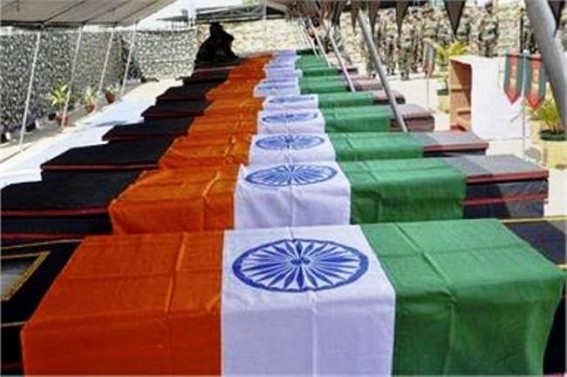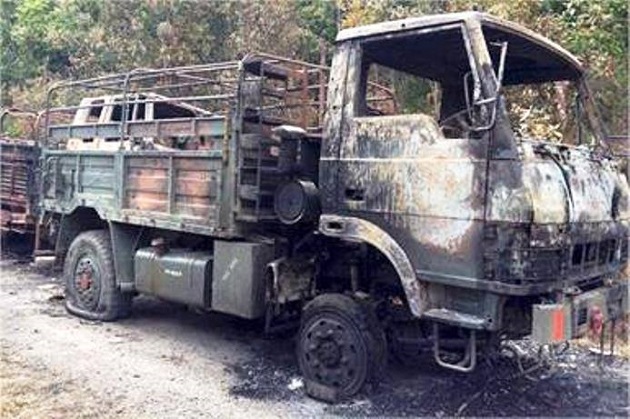Subir Bhaumik

PHOTO : Coffins of martyred Jawans of Dogra regiment at Imphal waiting for air transport to New Delhi. TIWN Photo
Insurgency is back with a bang in Northeast specially in the states along the India-Myanmar frontier. Tripura may take satisfaction that Bangladesh has Sheikh Hasina in power whose 'zero-tolerance' to terror makes it impossible for the likes of NLFT and ATTF to survive but if the shadow of insurgency lengthens from Manipur into Mizoram, Tripura will have to count its days of peace.
Manik Sarkar's government has done absolutely the right thing by repealing the AFSPA from Tripura. At the current level of insurgent violence , with incidents few and far between, there is no need to impose such an draconian act that is often misused. But there is no room for the Sarkar government to drop guard and efforts should be made to take on the remaining nucleus of the NLFT without any delay.
They still maintain some bases in very remote areas of Bangladesh's Chittagong Hill Tracts where the Bangladesh army or para-military hardly has any presence. Manik Sarkar's government must use its excellent relations with Sheikh Hasina to smash these last hideouts.
Any government, state or Centre, needs to be tough in tackling insurgency but should be extremely compassionate in addressing the issues of the tribals whose sense of alienation and marginalisation fuels insurgency. It is high time Tripura moves into next gear -- from handling insurgency to unfolding a definitive roadmap of ethnic reconciliation that will bring durable peace to Tripura and unprecedented economic growth.
My friend Saumen Sarker, a very successful IT professional in US, a Vice President with a major Bank in New York but who remains intensely passionate about Tripura ( as myself) , has already provided a detailed roadmap for developing Tripura's IT industry by taking advantage of the agreement by which Bangladesh will sell surplus bandwidth to India through Agartala. With Mamata Banerji's unhelpful attitude possibly driving away the likes of Infosys, Manik Sarkar's administration must take the opportunity to touch base with the IT majors and set up without any delay a big IT park with all necessary infrastructure that Saumen has detailed in his column in TIWN.
But one must congratulate the Manik Sarkar government for having first tackled insurgency the hard way and now setting an example by getting rid of the AFSPA. It should now find land for landless tribal farmers ( I suggest decommission Dumbur hydel) but it should also train tribals ( some of whom have access to English missionary education) in IT so that they are employable. With all the trade and transit agreements signed during Modi's Dhaka visit, Tripura is the next gateway to Northeast . The days when Assam would use that advantage to browbeat other smaller states in the region is over. So, comrades, this is the time to take our beloved state to the next level of social and economic development. It pains to hear that even after succesful implementation of poverty alleviation schemes, a tribal Ranjit Tanti has to sell his newborn baby for Rs 4500 because he is not sure he can feed and educate the child. I dont seek to blame anyone or bring politics into it , but is this not truly painful.
Now about the resurgence of insurgent activities on the India-Myanmar border.
The Naga insurgency is India's oldest separatist rebellion but it has remained dormant for 17 years since the Issac-Muivah faction of National Socialist Council of Nagaland (NSCN) joined talks with Delhi and declared a ceasefire. Later, the NSCN's Khaplang faction also declared ceasefire in 2000.
The Khaplang faction suffered two splits -- one when Khitovi Sena and Khole Konyak broke away from Burmese Naga rebel leader S S Khaplang . Now this year, when Khaplang decided not to renew his ceasefire with India, there was another split and two Indian Naga leaders Wangting Ao and P Thikhak broke away from Khaplang.

Militants ambushed Army convoy. TIWN Photo
Indian intelligence and Home Ministry officials, who conduct the Naga peace process had good reasons to believe that Khaplang will be isolated in his bases in Myanmar's Sagaing province because the Muivah-Issac, the Khole-Khitovi and the Wangting-Thikhak factions of NSCN were all determined to block out Khaplang .
But Khaplang seems to strategized brilliantly.
He had long complained to Delhi which refused to engage his faction in the Naga peace process on grounds that he was a Burmese national and India could not talk to a foreigner on a problem it believed was its own.
In recent years , Khaplang has been under huge pressure from Delhi which wanted the Burmese Naga leader to stop giving shelter to active rebel groups of northeast in his remote bases in Sagaing division.
Khaplang pulled off a coup of sorts by arriving at a truce with Myanmar’s Thein Sein government in 2012. That ensured his bases in Sagaing will always be safe from attacks by the Tatmadaw (Burmese army) that did not, in any case, seem much interested in chasing the northeast Indian rebels out of its territory, as Bhutan and Bangladesh had done .
Now with Delhi indicating this year that it would not renew the ceasefire unless Khaplang stopped sheltering other rebel groups like the ULFA of Assam or the Manipuri and Bodo rebel groups, the Burmese Naga warlord pulled out of the truce without much ado to ‘intensify the fight for Naga independence’ in March.
A month later, he floated the United National Liberation Front of Western South-East Asia (UNLFWSEA) with few other rebel groups like the ULFA (Paresh Barua faction) , the KLO, NDFB (Songjibit faction), KYKL and KCP of Manipur.
The two top Meitei rebel groups, UNLF and PLA stayed away because of apparent leadership hassles, but decided to cooperate with the UNLFSWEA in staging attacks on Indian forces.
Then in the last two months, fighters of the UNLFSWEA have resumed attacks on Indian army and para-military forces all along the India-Myanmar frontier.
In atleast six attacks so far in Arunachal Pradesh, Nagaland and Manipur, 35 Indian soldiers have been killed and scores of others injured. In the latest attack in Manipur’s Chandel district , the rebels displayed a much better tactical sense and better use of sophisticated weapons like land mines and rocket propelled grenades , leading to high casualties in the ranks of the 6th Dogra regiment.
Khaplang may have been isolated in the Naga political process, but he has used his ‘Sagaing card’ brilliantly to gain allies in the other ongoing insurgent movements of Northeast.
After Bhutan and Bangladesh went all out against anti-Indian rebels based in their territory and Delhi’s regional diplomacy helped neutralized potential staging posts of trans-border insurgencies, Khaplang’s bases in Myanmar’s Sagaing Division remain the only safe trans-border base for northeastern insurgents.
Khaplang’s control over these bases makes him a natural leader of an anti-Indian rebel coalition like UNLFWSEA . No wonder, he emerged as its chairman and not R K Meghen, the UNLF chief from Manipur for whome some Manipuri groups had pitched for.
Indian intelligence reports indicate Khaplang and ULFA’s Paresh Barua have successfully negotiated a supply of Chinese weapons through pro-Beijing surrogates in Myanmar like the United Wa State Army and the Kokang MNDAA .
That gives rise to suspicions that Beijing’s spymasters may have played a discreet role in getting Khaplang and Barua to float the UNLFWSEA in much the same way they have got the United Wa State Army (UWSA) to take the initiative to forge an anti-Myanmar coalition of non-Burman rebel armies. A conference of these armies was held at the UWSA headquarters in May .
Beijing’s use of the ‘rebel factor’ against both Myanmar and India is historical , though dating back to the Mao-Zhou era when several batches of Naga and Mizo fighters trekked to Yunnan for training and the southwestern Chinese state emerged as the staging post for massive Burmese Communist offensives in the 1960s . Beijing may no longer encourage export of revolution , like in the Mao era, but if it is disturbed by India or Myanmar drawing close to Western powers like US, it has the option to play the ‘rebel card’. Paresh Barua has told journalists in interviews ( this writer included) that the only prospect for gaining independence is through an intense Sino-Indian conflict. And the Assamese warlord has tried to forge a rebel coalition since 2011, when he first moved to Ruili on the China-Myanmar border after being forced to leave Bangladesh.
That the likes of Barua and NDFB’s Songjibit see in Khaplang’s safe Sagaing bases the only chance of keeping alive the last flicker of their insurgent movements and that Khaplang is too willing to play host to these allies because they provide him some strike power in Indian territory to remind Delhi he is too dangerous to be ignored are factors that Indian intelligence will now have to keep in mind while reworking their Northeastern strategy.
The series of attacks on Indian forces in the last two months may help Delhi refocus its strategy now with no illusions about the Burmese Naga warlord. Myanmar has fought shy of attacking the Sagaing bases because it has other much stronger ethnic rebel groups in Kachin, Kokang and Karen areas to contend with . But India will have to get to start coordinated operations with the Burmese army to flush out the rebels if peace had to be brought back to Northeast.
Delhi cannot look the other way if Khaplang attacks its forces from the safe bases of Sagaing where a truce with the Tatmadaw allows his fighters to freely around with weapons and extort money or trade in local products. Latest reports even suggest Khaplang is recuperating in a Yangon hospital in full knowledge of Burmese military intelligence even as his fighters rain hell in the hills of northeast India.
Myanmar is crucial to unlocking Manipur's "Eastern Gates" for the success of India's Look East policy, which cannot unfold to its full potential if the Northeast is held hostage by ethnic militancy. To make sense to 'Act East', Delhi has to act hard and fast against the raging priarie fires in Northeast.
 To send your appreciation and comments pl. send email to editor@tripurainfoway.com or tripurainfoway@gmail.com or post online below.
To send your appreciation and comments pl. send email to editor@tripurainfoway.com or tripurainfoway@gmail.com or post online below.- Why Modi’s BJP swept key India regional elections
- TIWN’s landmark legal victory against BJP Govt’s Illegal attacks to shutdown fearless Media
- India to be world's third-largest economy by 2030 -S&P Global Ratings
- Tripura's Dark Era : Mafia style Brutal attacks on Journalists, fight for your Citizen rights !
- How to access tripurainfoway.com via HOLA from India



